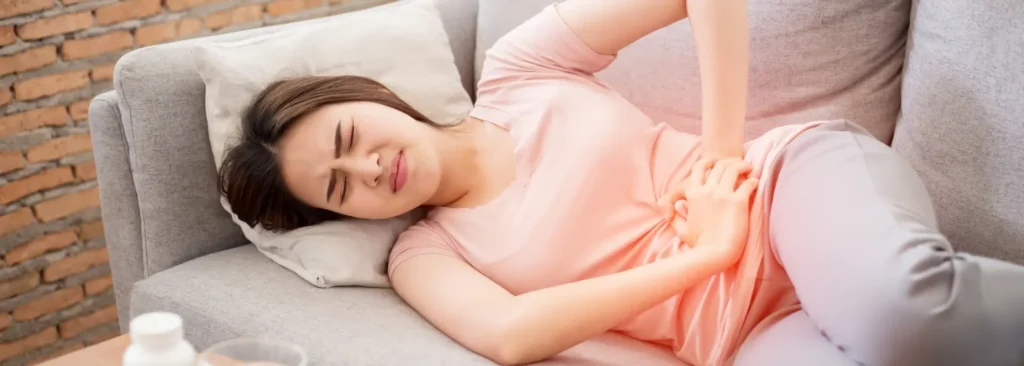Painful Periods & Pelvic Floor Therapy

Painful menstrual cramps, medically known as dysmenorrhea, are remarkably common, affecting up to 95% of women. These often debilitating symptoms can significantly interfere with daily activities, impacting overall well-being, and may also signal underlying gynecological issues –Research. Here are some conditions that can cause painful periods (dysmenorrhea), listed roughly in order of how commonly they are a cause of this pain, from most to least common.
Uterine Contractions (Primary Dysmenorrhea) & Pelvic Floor Therapy
Many women experience temporary abdominal pain and cramping during their menstrual cycles, a condition known as dysmenorrhea. This pain is primarily caused by the uterus contracting to shed its lining. These contractions are regulated by hormone-like substances called prostaglandins. Elevated levels of these prostaglandins can lead to stronger uterine contractions, which are often felt as intense period pain. This common type, often called primary dysmenorrhea, typically begins in adolescence around the time of the first period and tends to become less severe with age or after childbirth.
Pelvic floor physical therapy can help manage dysmenorrhea by treating pelvic muscle tension and dysfunction, the common origin of pain. Through manual therapy, exercises, and education tight muscles can be released, referred pain reduced, muscle coordination improved, coping and relaxation strategies learned, complementing any pain relievers or prescribed medication you may be taking.
Uterine Fibroids & Pelvic Floor Therapy
These noncancerous growths in the wall of the uterus and though many cause no symptoms at all, some can trigger heavy bleeding, pelvic pain, and extend the length of your period. Uterine fibroids are very common, affecting an estimated 70% to 80% or more of women by age 50 and most frequently found between the ages of 30 and the early 50s.
Pelvic floor physical therapy does not directly treat uterine fibroids however it can be a helpful supportive therapy to manage symptoms such as pelvic pain. Pelvic floor physical therapy can release muscle tension caused by pain or pressure from fibroids, reducing referred pain, improving muscle function to better cope with fibroid bulk, and teaching pain management strategies. It complements, but does not replace, medical treatments.
Endometriosis & Pelvic Floor Therapy
The endometrium is the tissue that lines the uterine wall and is shed during menstruation. Endometriosis is a disorder when this tissue is found outside of the uterus, usually in the pelvic and abdominal region. It affects roughly 1 out of 10 women and it could take many years and specialist visits to get correctly diagnosed. Women are more likely to be diagnosed with endometriosis if they had their period early, have a history of long, heavy periods, and a family history. Exposure to endocrine disrupting chemicals and environmental toxins in utero. Thus, there are both environmental and genetic factors that can contribute to developing endometriosis. In addition to severe period pain, individuals with endometriosis can also experience pain with sex, painful bowel movements and urination, urinary frequency and urgency, and struggle with infertility.
The gold standard for diagnosing and treating endometriosis is laparoscopic surgery, usually by excising the lesions. Medication and hormonal therapies can also be prescribed to manage pain and symptoms. As with other pelvic pain diagnoses, conservative treatment includes pelvic floor physical therapy to target tight, irritated muscles and soft tissue and correct pelvic floor dysfunction. A good home program focusing on stretching, trigger point therapy, and self massage techniques can also be helpful in between sessions. A pelvic floor physical therapist or your physician can also discuss proper diet/ nutrition to ease abdominal bloating, gas, and motility issues, improve gut health, and decrease inflammation associated with endometriosis.
Adenomyosis & Pelvic Floor Therapy
Occurs when the endometrial tissue grows into the muscular wall of the uterus. Symptoms vary, with some women having none, while others experience significant issues including heavy and prolonged menstrual bleeding, severe menstrual cramps and pain, chronic pelvic pain, painful intercourse, and a feeling of abdominal bloating or pressure due to an enlarged uterus.
Pelvic floor physical therapy does not treat Adenomyosis itself but helps manage its symptoms, particularly pain. Pelvic floor physical therapy works by releasing muscle tension caused by chronic pain, managing referred pain, helping to calm a sensitized nervous system, while improving muscle function related to an enlarged uterus, and teaching coping strategies. It serves as a supportive therapy alongside medical treatments for Adenomyosis.
Pelvic Inflammatory Disease & Pelvic Floor Therapy
This a relatively common infection that’s most prevalent among younger, sexually active women (aged 15-25) and is frequently caused by untreated sexually transmitted infections like chlamydia and gonorrhea. While not as widespread as primary menstrual cramps, Pelvic Inflammatory Disease is a significant health concern due to its potential long-term complications. An infection of the reproductive organs can cause significant pelvic pain, including during periods.
Pelvic floor physical therapy does not treat the active Pelvic Inflammatory Disease infection, which requires medical treatment like antibiotics, but it can be beneficial for women who develop chronic pelvic pain after the infection has been cleared. In these situations pelvic floor physical therapy can help release muscle tension caused by pain along with any scar tissue irritation or referred pain.
Additional Reasons for Painful Periods & Pelvic Floor Therapy
Increased menstrual pain can be linked to various factors, including the initial uterine reaction to certain IUDs (especially copper, causing stronger cramping contractions), pelvic pain from ovarian cysts that may worsen during menstruation, and less commonly, other medical conditions like Irritable Bowel Syndrome (IBS) or chronic pelvic pain syndrome which can either exacerbate or be mistaken for painful periods. Know that pelvic floor physical therapy can indirectly help women coping with general pelvic pain, even when the pain originates from various non-musculoskeletal sources (like endometriosis, fibroids, bladder issues, bowel problems, etc.).
In general persistent pain, particularly in the pelvis, triggers the surrounding muscles to tighten in an act of protection. This chronic muscle tension can become a secondary source of pain, creating a cycle where the original persistent pain causes tension, and the tension causes more pain. Pelvic floor physical therapy works indirectly on these muscles to release the tension, helping to break this cycle. So, while it doesn’t fix the original cause of the pain if it’s not a muscle issue itself (like shrinking a fibroid or curing an infection), it effectively treats the musculoskeletal and neurological responses to that pain, reduce overall pain levels, improve function, and provide you with tools to better cope with pelvic pain from a variety of sources.
Learn More

“…..She [Dr. Kim]…is extremely knowledgeable, innovative and thorough in her treatments and explanations….” – A.S
“…Helen is an excellent physical therapist, whose holistic approach helped me improve my overall health and well-being..” – C.C.
“…Helen helped me through my pregnancy with twins and post-partum with everything from terrible back pain to fixing my severe diastasis recti…” – L.G.
“…She [Dr. Kim] is one on one and focuses on your individual needs, I have been going to her for ten years and there is nobody in nyc I trust more…”